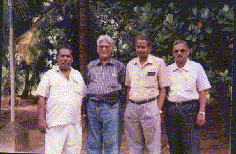RESEARCH
RESTORATION OF SENSATION IN LEPROSY

This is being achieved at this centre in two ways
depending on the duration of loss of sensation.
1. Within six months of loss of sensation medical
treatment or surgical decompression when indicated restores the sensation
in majority of cases. Many papers have been published from this institution
on this subject.
2. After one year of paralysis of a trunk nerve,
the nerve does not recover its function. In these cases excision
of the diseased portion of the nerve and its replacement by an autologous
skeletal muscle graft has shown appreciable sensory recovery in nearly
50% of cases (research results to be published).
The background of this research is:
The technique of using muscle graft replacing
diseased or injured segments of peripheral nerves in animal experiments
at Royal College of Surgeons of England, produced successful results. (Pereira
et al, JBJS, 1990).
The technique was found to be successful in the
repair of digital nerves in humans and comparison of this technique with
conventional end to end suturing repair showed superior results (Pereira
et al, International Journal of Hand Surgery – 1991).
Previous studies of nerve muscle grafting at both
Sacred Heart Leprosy Centre, Kumbakonam, India and at ALERT, Addis Ababa,
Ethiopia, have shown some recovery of nerve function although in no case
has the functional recovery approached normality. In the majority
of cases, there was some useful recovery of sensation.
The recovery of sensation, even though observed
in a few cases two years after operation, continues to improve slowly and
in some cases take five years to manifest. There is reduced occurrence
of plantar ulcers and these patients start sensing the surfaces as they
walk on stones, pebbles etc. Better results are noted in median
than in posterior tibial nerves.
A new research project is planned aimed at restoration
of sensation by operating in patients with a shorter duration of paralysis
and the disease.
All these projects have been fully supported and
funded by LEPRA (U.K. and INDIA). We are thankful for the active
and consistent collaboration of Dr.Jerome H.Pereira, Dr.Dinkar D.Palande
and Dr.T.S.Narayanakumar. Also we are especially thankful to Prof.Bowden
and Prof.J.L.Turk, from the Royal College of Surgeons of England who gave
us active support.